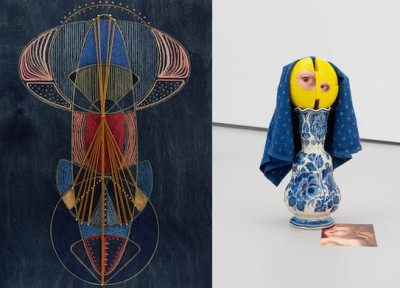- Artist Talk
Johanna Unzueta / Moira Zoitl – The Many Names of Blue
In conversation with the artists Johanna Unzueta and Moira Zoitl, the curator of the exhibition “This Might Be A Place For Humningbirds”, Antje Weitzel, explores the history of indigo and the cultural traditions and techniques of dyeing with this color. Indigo or Nila, Añil, Xiquilite, Aizome has been used and traded as a dye in Southeast Asia, the Middle East, Africa and the Americas since ancient times. Its history reveals colonial trade practices and routes closely linked to the exploitation of natural resources and people.
In Guatemala, indigo was already produced by the Maya from indigenous plants in the late pre-classical period. It is one of the components of the so-called Mayan blue. Under Spanish colonial rule in 1760, indigo became a successful export product of the Kingdom of Guatemala, the administrative center of the Spanish Empire in Central America and the center of the indigo trade. The indigo boom decreased with the strong competition from the US plantations and India and finally ceased with the development of synthetic indigo. The synthesis route developed by Adolf von Baeyer for the Badische Anilin- und Soda-Fabrik (BASF) led to the collapse of the markets for natural indigo. Today, indigo is mainly used to dye denim cotton fabrics for the production of blue jeans.
Indigo, which is naturally derived from plants, plays a central role in Johanna Unzueta’s work. In the exhibition “This Might Be A Place For Humningbirds”, Unzueta shows new three-dimensional drawings that are the product of her work with indigo dyeing techniques in Guatemala. For several years now, the artist has been working closely with various initiatives in Guatemala that experiment with natural indigo and attempt to reactivate and promote ethical, purely natural dyeing techniques.
In her project “According to blueprint” Moira Zoitl deals with the origins of blueprint and its spread in Central Europe. Blueprint is a textile printing process with blue and white patterns using indigo as a dye. By means of performance, cyanotypes (iron blue prints), objects and fabrics, Zoitl creates references to the complex cultural-historical meanings of the colour blue, but also to colonial mechanisms of exploitation, as captured in a photo series by the photographer Oscar Mallitte from 1877. On view are the processes and working conditions in an indigo factory in Allahabad, India. In collaboration with the artist Sajan Mani, Zoitl created a video work that translates the production methods of the raw material indigo and its use for blue dyeing into performative actions along the photographic documents.
The event is part of the project “This might be a place for humming birds”, curated by Çağla Ilk and Antje Weitzel, which is on show on 16 November 2019 – 5 February 2020 at Galerie im Körnerpark, Berlin-Neukölln.
Supported by the Senate Department for Culture and Europe / Programme Open-Sector Funding, and the Institute for Foreign Cultural Relations (ifa).
